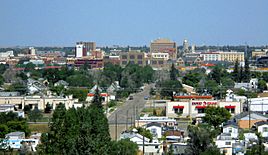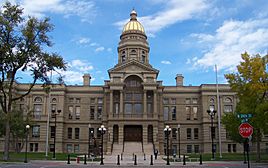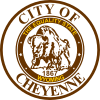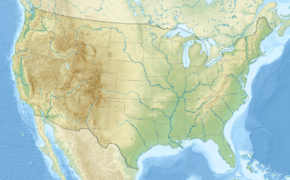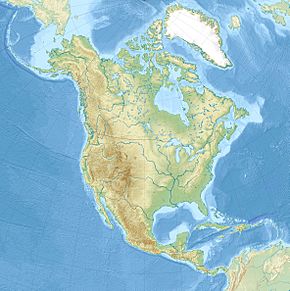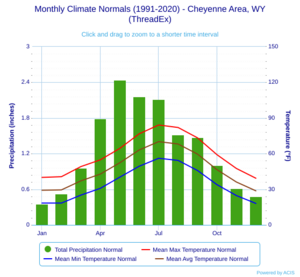Cheyenne, Wyoming facts for kids
Quick facts for kids
Cheyenne
|
|||
|---|---|---|---|
|
State capital and city
|
|||
|
Left to right from top: Downtown Cheyenne, Cheyenne Depot Museum, Union Pacific Big Boy 4004 and the Wyoming State Capitol
|
|||
|
|||
| Nickname(s):
"Magic City of the Plains" (historic)
|
|||
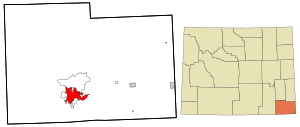
Location in Laramie County in Wyoming
|
|||
| Country | United States | ||
| State | Wyoming | ||
| County | Laramie | ||
| Founded | 1867 | ||
| Named for | Cheyenne people | ||
| Area | |||
| • City | 32.37 sq mi (83.84 km2) | ||
| • Land | 32.26 sq mi (83.55 km2) | ||
| • Water | 0.11 sq mi (0.29 km2) 0.45% | ||
| Elevation | 6,086 ft (1,855 m) | ||
| Population
(2020)
|
|||
| • City | 65,132 | ||
| • Density | 1,991.23/sq mi (768.82/km2) | ||
| Time zone | UTC−7 (Mountain) | ||
| • Summer (DST) | UTC−6 (Mountain) | ||
| ZIP Code |
82001–82003, 82006–82010
|
||
| Area code(s) | 307 | ||
| FIPS code | 56-13900 | ||
| GNIS feature ID | 1609077 | ||
Cheyenne is the capital city of Wyoming, a state in the United States. It is also the largest city in Wyoming. About 65,132 people lived there in 2020. Cheyenne is the main city of the larger Cheyenne metropolitan area, which had over 100,000 residents in 2020.
The city was founded in 1867. Its name comes from the Cheyenne Native American people. Cheyenne is special because it is one of only three state capitals in the U.S. that has a Native American name, located in a state that also has a Native American name. The city is found in the Southern Rocky Mountain Front region, near Crow Creek and Dry Creek.
Contents
History of Cheyenne
How Cheyenne Began
On July 4, 1867, a man named Grenville M. Dodge from the Union Pacific Railroad announced that a new town would be built. This town would be the railroad's main base in the mountains. It was planned next to a bridge the railroad wanted to build over Crow Creek. At the same time, Major General Christopher C. Augur said that a U.S. Army fort would be built nearby. This fort would help protect the railroad.
The Union Pacific Railroad officially planned the town on July 5, 1867. People decided to name the town Cheyenne after the Cheyenne Native American people. On August 8, 1867, Cheyenne became an official town. Just two days later, H. M. Hook was elected as its first mayor. The railroad tracks reached Cheyenne on November 13, 1867, and the first train arrived the next day. Cheyenne grew so fast that people called it the "Magic City of the Plains."
Fort D.A. Russell and the Air Force Base
On September 8, 1867, the United States Army created Fort D.A. Russell. It was named after Brigadier General David Allen Russell. At first, it was a cavalry camp, and building the fort started the next month. In 1930, the fort was renamed Fort Francis E. Warren to honor Francis E. Warren, the first Governor of the State of Wyoming. Later, in October 1949, the fort became part of the new United States Air Force and was called Francis E. Warren Air Force Base.
Wyoming's Capital City
On July 25, 1868, the Territory of Wyoming was formed. The first Territorial Governor, John Allen Campbell, arrived in Cheyenne on May 7, 1869. He made Cheyenne the temporary capital of the territory. Cheyenne has been the only capital of Wyoming ever since.
On December 10, 1869, the first meeting of the Wyoming Territorial Legislature happened in Cheyenne. On that day, they passed a law to officially make Cheyenne a town in Wyoming Territory. They also passed a very important law: they gave women the right to vote. Wyoming was the first U.S. state or territory to allow women to vote!
On July 10, 1890, Wyoming officially became a state in the Union. The Wyoming State Capitol building was built between 1886 and 1890. More improvements were added in 1917.
Cheyenne Regional Airport's Role
The Cheyenne Regional Airport opened in 1920. It first served as a stop for airmail planes. Over time, it became an airport for both civilian and military planes. During World War II, many large planes like B-17s and B-24s were fixed and updated there. Today, the airport is still used by the military. It also helps test civilian planes at high altitudes.
Geography and Climate
Where is Cheyenne Located?
Cheyenne is in the southeast corner of Wyoming. It is one of the state capitals that is not in the very center of its state. Other examples include Carson City, Nevada and Juneau, Alaska.
The city covers about 24.63 square miles (63.8 square kilometers). Most of this area is land, with a small part being water.
Cheyenne's Climate and Weather
Cheyenne has a cold semi-arid climate. This means it's generally dry and cool. Winters are cold and last a while, but they are not very snowy. Temperatures often stay above freezing. However, warm winds called chinook winds can blow from the nearby Rocky Mountains. These winds can make winter days much warmer.
Even though December is the coldest month, most snow falls in March and April. On average, Cheyenne gets about 60 inches (152 cm) of snow each year. Summers are warm, but the temperature changes a lot between day and night. In July, the average temperature is about 69.4°F (20.8°C). Temperatures can reach 90°F (32°C) about twelve days a year.
The highest temperature ever recorded in Cheyenne was 100°F (38°C). The lowest was -38°F (-39°C). The city gets about 15.9 inches (404 mm) of rain each year. Most of this rain falls from May to August. Cheyenne gets a lot of sunshine, about 2980 hours each year.
On July 16, 1979, an F3 tornado hit Cheyenne. It was the most damaging tornado in Wyoming's history. One person died and 40 people were hurt.
| Climate data for Cheyenne Regional Airport, Wyoming (1981–2010 normals, extremes 1872−present) | |||||||||||||
|---|---|---|---|---|---|---|---|---|---|---|---|---|---|
| Month | Jan | Feb | Mar | Apr | May | Jun | Jul | Aug | Sep | Oct | Nov | Dec | Year |
| Record high °F (°C) | 66 (19) |
71 (22) |
77 (25) |
83 (28) |
91 (33) |
100 (38) |
100 (38) |
98 (37) |
95 (35) |
85 (29) |
75 (24) |
69 (21) |
100 (38) |
| Mean daily maximum °F (°C) | 39.5 (4.2) |
40.5 (4.7) |
47.5 (8.6) |
54.9 (12.7) |
64.7 (18.2) |
75.3 (24.1) |
83.4 (28.6) |
81.2 (27.3) |
71.8 (22.1) |
58.8 (14.9) |
46.5 (8.1) |
38.2 (3.4) |
58.5 (14.7) |
| Mean daily minimum °F (°C) | 18.0 (−7.8) |
18.6 (−7.4) |
24.4 (−4.2) |
30.8 (−0.7) |
40.2 (4.6) |
48.9 (9.4) |
55.5 (13.1) |
54.1 (12.3) |
44.7 (7.1) |
33.9 (1.1) |
24.2 (−4.3) |
17.3 (−8.2) |
34.2 (1.2) |
| Record low °F (°C) | −38 (−39) |
−34 (−37) |
−21 (−29) |
−8 (−22) |
8 (−13) |
25 (−4) |
33 (1) |
25 (−4) |
8 (−13) |
−5 (−21) |
−21 (−29) |
−28 (−33) |
−38 (−39) |
| Average precipitation inches (mm) | 0.33 (8.4) |
0.47 (12) |
1.05 (27) |
1.78 (45) |
2.34 (59) |
2.34 (59) |
2.19 (56) |
1.95 (50) |
1.48 (38) |
0.93 (24) |
0.59 (15) |
0.49 (12) |
15.94 (405) |
| Average snowfall inches (cm) | 5.9 (15) |
7.9 (20) |
11.3 (29) |
10.2 (26) |
2.3 (5.8) |
trace | 0 (0) |
0 (0) |
1.3 (3.3) |
5.0 (13) |
8.0 (20) |
8.4 (21) |
60.3 (153) |
| Average precipitation days (≥ 0.01 in) | 4.9 | 6.2 | 8.6 | 10.3 | 12.4 | 11.4 | 10.7 | 11.0 | 8.3 | 7.4 | 6.4 | 6.2 | 103.8 |
| Average snowy days (≥ 0.1 in) | 5.7 | 6.5 | 7.8 | 6.1 | 1.8 | 0.1 | 0 | 0 | 0.7 | 3.4 | 6.1 | 6.8 | 45.0 |
| Average relative humidity (%) | 52.5 | 54.6 | 56.1 | 54.3 | 55.8 | 53.5 | 51.3 | 51.4 | 51.5 | 50.0 | 53.6 | 54.0 | 53.2 |
| Mean monthly sunshine hours | 190.7 | 202.6 | 253.1 | 271.9 | 291.9 | 303.2 | 317.5 | 297.4 | 262.3 | 237.0 | 178.8 | 175.4 | 2,981.8 |
| Percent possible sunshine | 64 | 68 | 68 | 68 | 65 | 67 | 69 | 70 | 70 | 69 | 60 | 61 | 67 |
| Source: NOAA (relative humidity and sun 1961−1990) | |||||||||||||
| Climate data for Cheyenne | |||||||||||||
|---|---|---|---|---|---|---|---|---|---|---|---|---|---|
| Month | Jan | Feb | Mar | Apr | May | Jun | Jul | Aug | Sep | Oct | Nov | Dec | Year |
| Mean daily daylight hours | 10.0 | 11.0 | 12.0 | 13.0 | 15.0 | 15.0 | 15.0 | 14.0 | 12.0 | 11.0 | 10.0 | 9.0 | 12.3 |
| Average Ultraviolet index | 2 | 3 | 5 | 7 | 9 | 10 | 10 | 9 | 7 | 4 | 2 | 1 | 5.8 |
| Source: Weather Atlas | |||||||||||||
People of Cheyenne
Population Growth Over Time
| Historical population | |||
|---|---|---|---|
| Census | Pop. | %± | |
| 1870 | 1,450 | — | |
| 1880 | 3,456 | 138.3% | |
| 1890 | 11,690 | 238.3% | |
| 1900 | 14,087 | 20.5% | |
| 1910 | 11,320 | −19.6% | |
| 1920 | 13,829 | 22.2% | |
| 1930 | 17,361 | 25.5% | |
| 1940 | 22,474 | 29.5% | |
| 1950 | 31,935 | 42.1% | |
| 1960 | 43,505 | 36.2% | |
| 1970 | 41,254 | −5.2% | |
| 1980 | 47,283 | 14.6% | |
| 1990 | 50,008 | 5.8% | |
| 2000 | 53,011 | 6.0% | |
| 2010 | 59,466 | 12.2% | |
| 2020 | 65,132 | 9.5% | |
| 2022 (est.) | 64,610 | 8.7% | |
| U.S. Decennial Census 1870–2000 census |
|||
In 2020, Cheyenne had a population of 65,132 people. In 2010, there were 59,467 people living in the city. There were 25,558 households, which are groups of people living together in one home.
In 2010, about 30.2% of households had children under 18. Many households were married couples, while others were single parents or individuals living alone. The average household had about 2.29 people.
The median age in Cheyenne in 2010 was 36.5 years old. About 24% of residents were under 18. The city had slightly more females (50.7%) than males (49.3%).
Different Backgrounds in Cheyenne
In 2020, the U.S. Census Bureau estimated that about 77.1% of the people in Cheyenne were non-Hispanic white. Other groups included Black or African American, American Indian or Alaska Native, Asian, and Native Hawaiian or Pacific Islander. About 15.9% of the population was Hispanic or Latin American.
Fun Things to Do in Cheyenne
Cheyenne Frontier Days
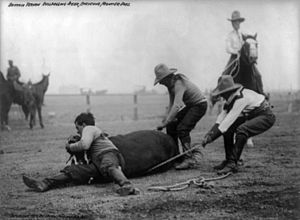
Cheyenne Frontier Days is a huge outdoor rodeo and western festival. It happens for ten days around the last full week of July. It's known as the biggest event of its kind in the world!
You can watch exciting events like bull riding, calf roping, and barrel racing. There are also parades and a carnival with rides, games, and shops. This festival has been a tradition since 1897.
Famous Places to Visit
Cheyenne has many interesting landmarks:
- Tivoli Building (Cheyenne, Wyoming)
- William Sturgis House
- Wyoming State Capitol
- F.E. Warren Air Force Base, which is one of the oldest active military bases in the U.S.
- Nagle Warren Mansion
- Frontier Mall (Cheyenne)
Historic Places on the National Register
More than 50 places in Cheyenne are listed on the National Register of Historic Places. This means they are important historical sites. Some of these include:
- The Historic Plains Hotel
- Atlas Theatre
- Union Pacific Depot (also known as the Cheyenne Depot Museum)
- The Wyoming Governor's Mansion
- Nagle-Warren Mansion
- Several historic churches like First Presbyterian Church and St. Mary's Catholic Cathedral.
- Old schools like Cheyenne High School and Park Addition School.
- The famous Big Boy Steam Engine.
- The Botanic Gardens Rotary Century Plaza & Steam Locomotive.
Several areas in the city are also historic districts, like the Downtown Cheyenne Historic District and Lakeview Historic District.
Sports and Recreation
Sports Venues in Cheyenne
Cheyenne has several places for sports. These include the Cheyenne Ice and Events Center, Pioneer Park, Powers Field, Bison Stadium, and Okie-Blanchard Stadium.
In 2020, Cheyenne hosted a historic Lethwei world title match. This ancient Burmese combat sport was held in North America for the first time. Wyoming is currently the only U.S. state where Lethwei is legal.
Parks and Outdoor Activities
The Cheyenne Community Recreation and Events Department manages many fun places. These include an Ice and Events center, a swimming pool, a spray park, and a skateboard park. They also run two golf courses and the Cheyenne Botanic Gardens. The Botanic Gardens include the Paul Smith Children's Village, which is great for kids.
You can rent paddle boats in Lions Park during the summer. The city also has cemeteries and manages forestry operations. There's a community house and a Youth Activity Center.
Cheyenne has a great Greater Cheyenne Greenway system, which is about 37 miles (60 km) long. This greenway connects parks and neighborhoods. It has many bridges and underpasses, so you can avoid busy roads and travel over waterways. In 1996, Cheyenne was named a "Trail Town USA" because of its greenway system.
Education in Cheyenne
All public schools in Cheyenne are part of Laramie County School District #1. There are four high schools: Central High, East High, South High, and Triumph High.
Cheyenne is also home to Laramie County Community College (LCCC). This college is one of seven campuses managed by the Wyoming Community College Commission.
The city also has a public library, which is part of the Laramie County Library System.
Media and News
For local news, Cheyenne has the Wyoming Tribune Eagle newspaper. There is also a TV station called KGWN.
Transportation in Cheyenne
Major Roads and Highways
Cheyenne is a key point for several major highways:
 I-25 – This interstate runs north-south and crosses I-80 southwest of Cheyenne.
I-25 – This interstate runs north-south and crosses I-80 southwest of Cheyenne. I-80 – This interstate runs east-west across the country and crosses I-25 southwest of Cheyenne.
I-80 – This interstate runs east-west across the country and crosses I-25 southwest of Cheyenne. I-180 – A shorter interstate that runs with US 85.
I-180 – A shorter interstate that runs with US 85. US 30 (Lincoln Highway) – An east-west route through the city.
US 30 (Lincoln Highway) – An east-west route through the city. US 85 (South Greeley Highway, Central Avenue (Southbound), Warren Avenue (Northbound)) – A north-south route through Cheyenne.
US 85 (South Greeley Highway, Central Avenue (Southbound), Warren Avenue (Northbound)) – A north-south route through Cheyenne. US 87 – This route runs with I-25 through Cheyenne.
US 87 – This route runs with I-25 through Cheyenne. WYO 210 (Happy Jack Road) – An east-west route from I-25/US 87 towards Laramie.
WYO 210 (Happy Jack Road) – An east-west route from I-25/US 87 towards Laramie. WYO 211 (Horsecreek Road) – Runs northwest from Cheyenne to Horse Creek.
WYO 211 (Horsecreek Road) – Runs northwest from Cheyenne to Horse Creek. WYO 212 (College Drive, Four Mile Road) – A north-south route that forms a beltway around Cheyenne.
WYO 212 (College Drive, Four Mile Road) – A north-south route that forms a beltway around Cheyenne. WYO 219 (Yellowstone Road) – A north-south route from US 85 near the airport.
WYO 219 (Yellowstone Road) – A north-south route from US 85 near the airport. WYO 221 (Fox Farm Road) – An east-west route from US 85 to WYO 212.
WYO 221 (Fox Farm Road) – An east-west route from US 85 to WYO 212. WYO 222 (Fort Access Road) – A north-south route to F.E. Warren Air Force Base.
WYO 222 (Fort Access Road) – A north-south route to F.E. Warren Air Force Base. WYO 225 (Otto Road) – An east-west route southwest of Cheyenne.
WYO 225 (Otto Road) – An east-west route southwest of Cheyenne.
Public Transportation
The Cheyenne Transit Program offers bus services around the Cheyenne area. For longer trips, you can take intercity buses from Express Arrow and Greyhound Lines.
Air Travel
Cheyenne Regional Airport has daily flights to Denver International Airport through United Express.
Railroads
The Union Pacific and BNSF railroads both have tracks that cross in Cheyenne. The city has railyards for both companies. Union Pacific's railyard is home to its famous steam locomotives, including 844 and 4014.
Famous People from Cheyenne
Many notable people have connections to Cheyenne:
- Rink Babka (1936–2022), an Olympic discus thrower.
- Vernon Baker (1919–2010), a Medal of Honor recipient.
- Bryant B. Brooks (1861–1944), a former governor of Wyoming.
- Harriet Elizabeth Byrd (1926–2015), the first African-American woman to serve in the Wyoming Legislature.
- Joseph M. Carey (1845–1924), a former mayor of Cheyenne and governor of Wyoming.
- Neil Diamond (born 1941), the famous singer, lived in Cheyenne as a child.
- John Godina (born 1972), an Olympic shot putter.
- Mark Gordon (born 1957), the current governor of Wyoming.
- Curt Gowdy (1919–2006), a well-known sportscaster.
- Mildred Harris (c. 1903–1944), an actress and first wife of Charlie Chaplin.
- Wild Bill Hickok (1837–1876), a famous gunfighter and lawman from the Old West.
- Tom Horn (1860–1903), an Old West lawman and scout.
- James Johnson (born 1987), a professional basketball player in the NBA.
- Chris LeDoux (1948–2005), a rodeo champion and country music star.
- Cynthia Lummis (born 1954), a U.S. Senator.
- Brandon Nimmo (born 1993), a baseball player for the New York Mets.
Sister Cities
Cheyenne has several sister cities around the world. These partnerships help promote cultural exchange and understanding.
 Bismarck, North Dakota, United States
Bismarck, North Dakota, United States Waimea, Hawaii County, Hawaii, United States
Waimea, Hawaii County, Hawaii, United States Lompoc, California, United States
Lompoc, California, United States Hammam Sousse, Tunisia
Hammam Sousse, Tunisia Lourdes, France
Lourdes, France Taichung, Taiwan
Taichung, Taiwan Voghera, Italy
Voghera, Italy Accra, Ghana
Accra, Ghana
Images for kids
See also
 In Spanish: Cheyenne (Wyoming) para niños
In Spanish: Cheyenne (Wyoming) para niños


